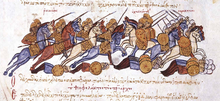
Back الغزو البيزنطي لقيليقية Arabic Βυζαντινή ανακατάληψη της Κιλικίας Greek Conquista bizantina de Cilicia Spanish Conquista bizantina della Cilicia Italian Византијско ослобађање Киликије Serbian
| Byzantine conquest of Cilicia | ||||||||||
|---|---|---|---|---|---|---|---|---|---|---|
| Part of the Arab–Byzantine wars | ||||||||||
 Niketas Chalkoutzes and his entourage escape during a battle between the Byzantines and the Arabs. Miniature from the Madrid Skylitzes | ||||||||||
| ||||||||||
| Belligerents | ||||||||||
| Byzantine Empire | Hamdanid Rebels | |||||||||
| Commanders and leaders | ||||||||||
| Strength | ||||||||||
| ||||||||||
The Byzantine conquest of Cilicia was a series of conflicts and engagements between the forces of the Byzantine Empire under Nikephoros II Phokas and the Hamdanid ruler of Aleppo, Sayf al-Dawla, over control of the region of Cilicia in southeastern Anatolia. Since the Muslim conquests of the 7th century, Cilicia had been a frontier province of the Muslim world and a base for regular raids against the Byzantine provinces in Anatolia. By the middle of the 10th century, the fragmentation of the Abbasid Caliphate and the strengthening of Byzantium under the Macedonian dynasty allowed the Byzantines to gradually take the offensive. Under the soldier-emperor Nikephoros II Phokas (r. 963–969), with the help of the general and future emperor John I Tzimiskes, the Byzantines overcame the resistance of Sayf al-Dawla, who had taken control of the former Abbasid borderlands in northern Syria, and launched a series of aggressive campaigns that in 964–965 recaptured Cilicia. The successful conquest opened the way for the recovery of Cyprus and Antioch over the next few years, and the eclipse of the Hamdanids as an independent power in the region.
© MMXXIII Rich X Search. We shall prevail. All rights reserved. Rich X Search